Huawei P10 and P10 Plus: Performance & Battery Life Report
by Matt Humrick on May 12, 2017 7:00 AM ESTBattery Life
The Huawei P10 pairs the Kirin 960 SoC with a 3200 mAh (12.23 Wh) battery, a small capacity bump from the P9’s 3000 mAh unit. The P10 Plus, which also uses the Kirin 960, gets a battery capacity increase too, up from the P9 Plus’ 3400 mAh to 3750 mAh (14.33 Wh). In our analysis of Kirin 960, we were surprised to see a regression in power efficiency relative to last year’s Kirin 950/955, despite using the newer Cortex-A73 CPU cores that are supposed to consume 20%-30% less power than the Kirin 950’s A72 cores (same process, same frequency), according to ARM; however, the Mate 9 (Kirin 960, 4000 mAh battery) managed to improve battery life relative to the Mate 8 (Kirin 950, 4000 mAh battery) by saving power elsewhere, notably with a more efficient display. Did Huawei find similar power savings with its P10 and P10 Plus?
To find out, we’ll run them through our standard suite of battery tests. To make the tests accurate and repeatable, we control as many variables as possible, including minimizing background tasks and calibrating each display to 200 nits at 100% APL.
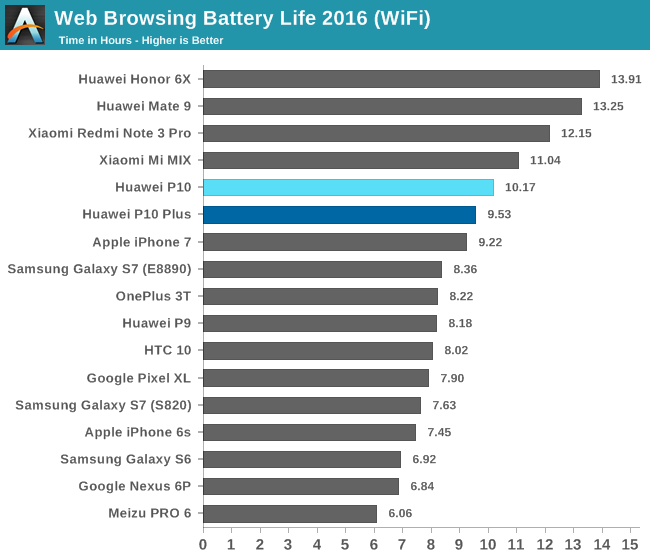
The P10 does quite well in our Wi-Fi browsing test that loads, pauses, and then scrolls through a set of popular websites while connected to Wi-Fi with the cellular radio turned off. Its 10 hours of screen on time is a 2 hour improvement on the P9. It definitely looks like Huawei has shaved power consumption from other components, because this increase is larger than what the bigger battery alone can explain. The P10 Plus uses more power on average than the P10 and its smaller, lower-resolution display, giving it just under 10 hours of screen on time in this test, which is still better than competing phones such as the Galaxy S7, OnePlus 3T, and Google Pixel XL.
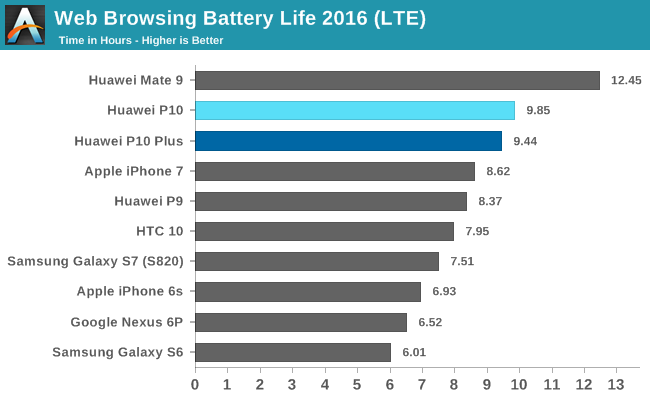
When using the cellular radio instead of Wi-Fi, the P10 once again lasts longer than the P10 Plus. The average platform power consumption (which is extrapolated from total runtime and battery capacity) is once again very similar between the P10 and Mate 9, with the P10 using 276-300mW less power on average than the P10 Plus.
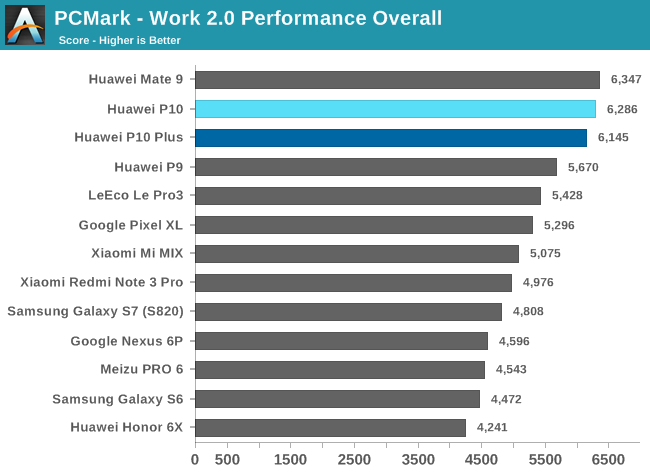
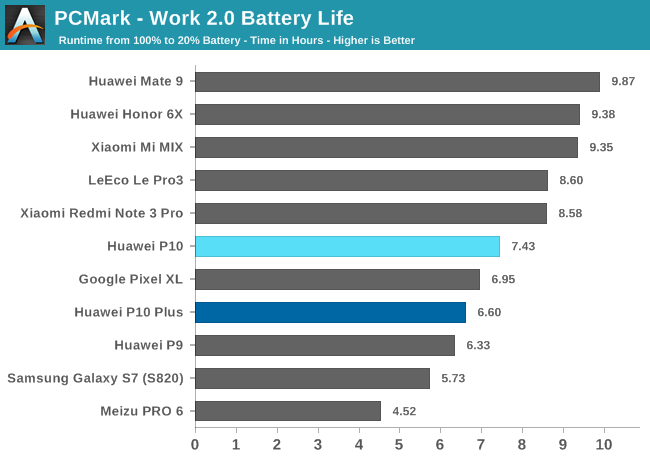
PCMark’s mixture of everyday workloads make better use of the CPU, GPU, and memory subsystems than our browsing battery life tests, which are still mostly limited by the power consumption of the display. With more work to do—and more frequent use of the big CPU cores and the GPU—the P10’s screen on time drops to just under 7.5 hours, a 1 hour improvement over the P9 and still a little longer than the Pixel XL. The P10 Plus only manages 6.6 hours, a far cry from the Mate 9’s nearly 10 hour duration. The Mate 9’s battery is only about 7% larger, but it lasts 50% longer in this test. Part of this difference is because of the particular Kirin 960 SoC in our P10 Plus sample, which draws more power than the parts in the P10 and Mate 9 (so a worse bin).


Most of the current flagship phones last around 3.5 hours when playing a game simulation like Manhattan ES 3.1, maybe a little longer if they have a larger-than-average battery. The P10 Plus only manages about 3 hours, the same as the P9, however. The smaller P10 dies about 15 minutes sooner, which is not a great result.
Of course we need to consider sustained performance too. As a general rule, the higher the performance the lower the battery life. The iPhone 7 is a good example; it delivers the best performance in this scenario but fails to match the battery life of its peers. The P10 sustains just over 18fps compared to about 9fps for the P9, so twice the sustained performance for only 15 fewer minutes of battery life. The P10 Plus manages just over 10fps sustained, similar to the P9, but it’s rendering onscreen at 1440p instead of 1080p like P9/P10. Factoring in display resolution, the P10 Plus offers similar sustained performance to other 1440p phones, such as the Galaxy S7, HTC 10, and Pixel XL, but falls about 0.5 hours short of these phones on battery life. The P10’s sustained performance is similar to the Le Pro3, OnePlus 3T, and Mi MIX, which all use lower-resolution 1080p displays, but it falls short on battery life, partially because these other three phones have larger batteries.
GPU Thermal Stability
The 1037MHz peak operating point Huawei uses for the Mali-G71MP8 GPU in the P10, P10 Plus, and Mate 9 is intended primarily for boosting benchmark scores and is not sustainable. All three phones only maintain peak performance levels for 1 minute (which just happens to be how long most graphics benchmarks last) before they begin reducing GPU frequency to avoid overheating. The P10 drops to 21fps after only 4 minutes, a 37% reduction relative to the peak value, before reaching equilibrium after about 30 minutes at around 18.3fps. This behavior is almost exactly the same as the Mate 9, except it drops to 21fps after 8 minutes and maintains 19fps afterwards, probably because its larger chassis can dissipate more heat. The P10 Plus also loses about 38% of its performance after 8 minutes.
The P10’s and Mate 9’s sustained performance is as good as or better than phones using Qualcomm’s Snapdragon 820/821 SoCs, though. The Moto Z Force Droid, with a newer GPU driver, can sustain a peak performance of almost 18fps for 12 minutes, gradually reaching a steady-state frame rate of 14.5fps, while the LeEco Pro 3, which uses a Snapdragon 821 SoC, can maintain 19fps after dropping from a peak value of 33fps. The Galaxy S7 edge also experiences a significant 33% drop in performance starting at the 8 minute mark, stabilizing at about 10fps after 31 minutes, similar to the P10 Plus’ 10.3fps when running at the same resolution.
Once the battery level drops to 10%, Huawei’s battery saving feature, which cannot be disabled, kicks in, reducing frame rate by more than 20%. There’s another step when the battery level hits 4%.
Battery Charging
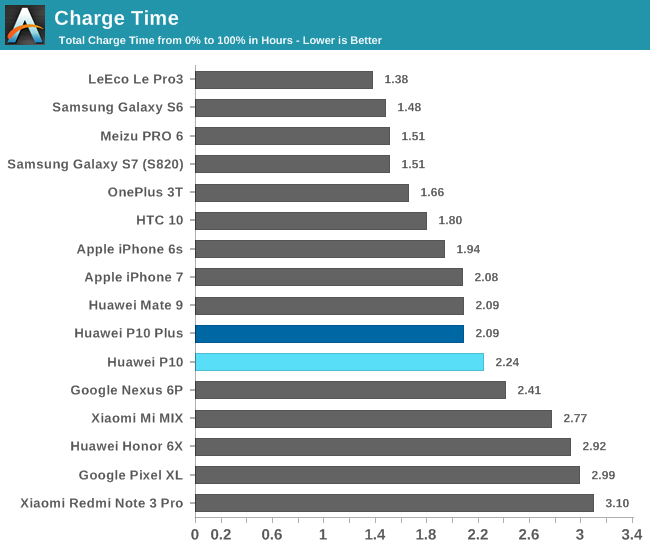
The P10 and P10 Plus include Huawei’s SuperCharge fast-charging technology that includes voltage, current, and temperature protection circuitry. The included wall charger is rated for 5V/2A (10W), 4.5V/5A (22.5W), and 5V/4.5A (22.5W) operation.
The P10 reaches a peak of about 16.2W at the battery shortly after being plugged in before settling around 12.5-13W. The battery charges to 25% in about 14 minutes and reaches 50% in about 31 minutes. The P10 Plus charges a little faster, initially spiking to 17.2W before settling around 14W. The P10 Plus’ battery charges to 25% in about 14 minutes and reaches 50% in about 30 minutes. Both P10s take just over 2 hours to be completely charged.



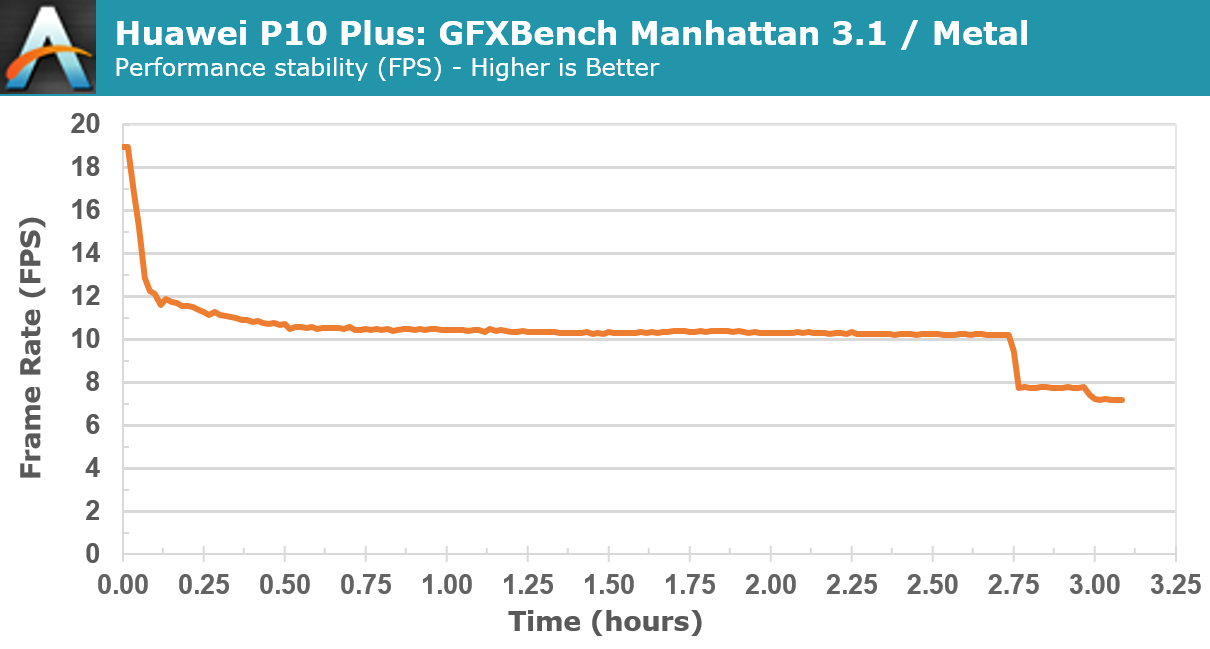
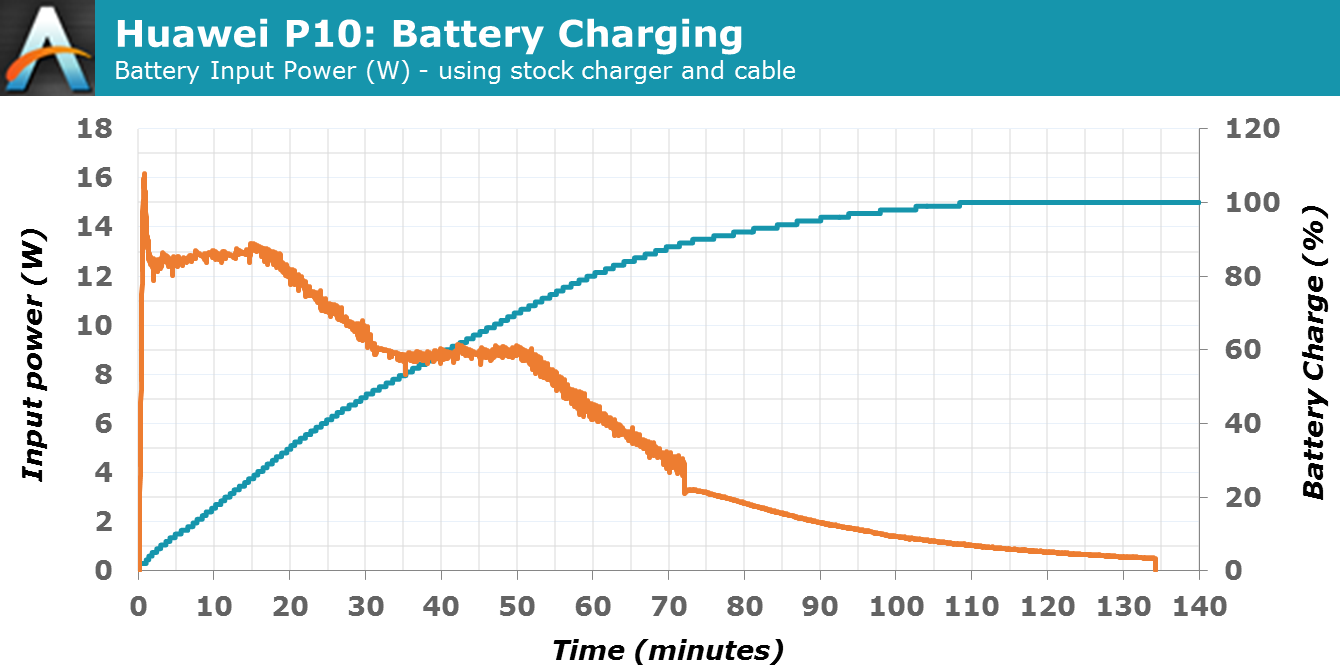
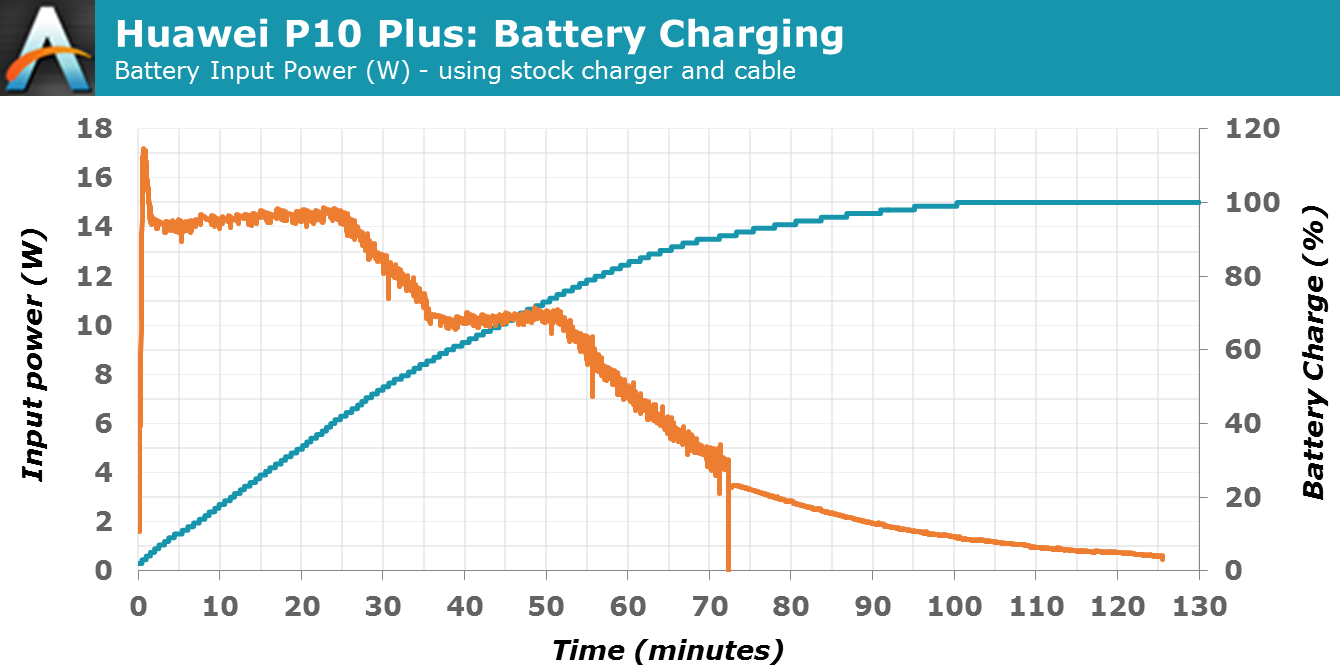








74 Comments
View All Comments
mimi013 - Thursday, June 15, 2017 - link
Now a days people depends on technology. Mobile Phone is one of them. New smartphone comes with different sensors and great features. Now world’s have many new brands mobile phone. Now all young people are more interested to phone. Recently Huawei released it’s new phones specification that is Huawei honor 9. Again In june 2017 Oppo R11, Oppo R11 Plus and Oppo F3 Plus was officially announced. And recently released a phone in Bangladesh called Walton Primo X4 Pro. Local product Walton Primo X4 Pro price in Bangladesh is 28,990 Taka. Again OnePlus also comes with its new phone oneplus 5. Have some Technology blogging site that provides all recent information about latest mobile phone and specification. To know about latest phone visit http://bit.ly/2tp41B7s.yu - Saturday, July 29, 2017 - link
"Huawei...'stated' that it never committed to using any specific type of NAND", well, the more accurate word would be "lied", though that's no surprise coming from Huawei, with its long history of dishonesty and shameless marketing tactics.Dersrr - Tuesday, August 8, 2017 - link
I remember reading that anandtech had to tweak chrome because the brightness is dimmer when opening chrome for some reason. I would sincerely appreciate it if some from anandtech could tell me what they did. I have a P10 plus. When I open chrome, the standard messaging app and contacts the screen dim down. When opening the multitask to se all apps running or pressing the home key, the brightness goes back up again.I have searched every setting in the phone but cannot find some setting to fix it. Had the same problem with the mate 9 pro. (No, I have no apps causing this and battery saving is off)
All the best. Dan.
alhsou - Sunday, August 20, 2017 - link
I've received my P10 yesterday and it seems like they have added a 3rd type of NAND to the device.I don't know if anadtech is running G the androbench with default settings but I get consistently over 714 MB/s in the Sequence read and also have double the performance in the random write test.